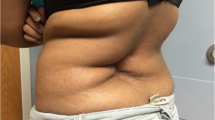Abstract
We designed a new pedicled fasciocutaneous flap for large sacral defects that combined a classic superior gluteal artery perforator flap and an acentric axis perforator pedicled propeller flap. We asked whether this technique would be simple and result in few complications. Six patients with large sacral defects had reconstruction using this technique in one stage. The size of the defect and postoperative complications in each patient were assessed. The minimum followup was 6 months (mean, 20.1 months; range, 6–38 months). All wounds healed with no recurrence during followup. Five patients achieved healing primarily, and another with minimal drainage achieved healing by secondary intention after a dressing change. No patients had deep infection, wound dehiscence, necrosis, or partial loss or shrinkage of the flap at final followup. The buttocks were symmetric. We consider this a good alternative for reconstructing large sacral defects because it is a relatively simple procedure and results in few complications.
Level of Evidence: Level IV, therapeutic study. See the Guidelines for Authors for a complete description of levels of evidence.



Similar content being viewed by others
References
Borman H, Maral T. The gluteal fasciocutaneous rotation-advancement flap with V-Y closure in the management of sacral pressure sores. Plast Reconstr Surg. 2002;109:2325–2329.
Chen TH. Bilateral gluteus maximus V-Y advancement musculocutaneous flaps for the coverage of large sacral pressure sores: revisit and refinement. Ann Plast Surg. 1995;35:492–497.
Colwell AS, Borud LJ. Autologous gluteal augmentation after massive weight loss: aesthetic analysis and role of the superior gluteal artery perforator flap. Plast Reconstr Surg. 2007;119:345–356.
Eo S, Kim D, Jones NF. Microdissection thinning of a pedicled deep inferior epigastric perforator flap for burn scar contracture of the groin: case report. J Reconstr Microsurg. 2005;21:477–450.
Grolleau JL, Collin JF, Chavoin JP, Costagliola M. [Iliac transosseous transposition of rectus abdominis muscle flap to cover a sacral pressure sore] [in French]. Ann Chir Plast Esthet. 1994;39:128–131.
Hai H, Dai H, Xu Y. [Combined treatment of refractory decubitus ulcers] [in Chinese]. Zhongguo Xiu Fu Chong Jian Wai Ke Za Zhi. 2006;20:909–911.
Hyakusoku H, Ogawa R, Oki K, Ishii N. The perforator pedicled propeller (PPP) flap method: report of two cases. J Nippon Med Sch. 2007;74:367–371.
Kankaya Y, Ulusoy MG, Oruç M, Yildiz K, Koçer U, Tüccar E. Perforating arteries of the gluteal region: anatomic study. Ann Plast Surg. 2006;56:409–412.
Keong N, Ricketts D, Alakeson N, Rust P. Pressure sore following elective total hip arthroplasty: pitfalls of misinterpretation. Ann R Coll Surg Engl. 2004;86:174–176.
Koshima I, Moriguchi T, Soeda S, Kawata S, Ohta S, Ikeda A. The gluteal perforator-based flap for repair of sacral pressure sores. Plast Reconstr Surg. 1993;91:678–683.
Lemaire V, Boulanger K, Heymans O. Free flaps for pressure sore coverage. Ann Plast Surg. 2008;60:631–634.
Leow M, Lim J, Lim TC. The superior gluteal artery perforator flap for the closure of sacral sores. Singapore Med J. 2004;45:37–39.
Li JH, Xing X, Li P, Xu J. Transposition movement of V-Y flaps for facial reconstruction. J Plast Reconstr Aesthet Surg. 2007;60:1244–1247.
Liu Y, Zhang X, Zhang C. [Clinical typing and surgical principle of pressure sore] [in Chinese]. Zhongguo Xiu Fu Chong Jian Wai Ke Za Zhi. 2007;21:932–936.
Menke H. [Infected decubitus ulcer] [in German]. Langenbecks Arch Chir Suppl Kongressbd. 1997;114:517–520.
Rajacic N, Gang RK, Dashti H, Behbehani A. Treatment of ischial pressure sores with an inferior gluteus maximus musculocutaneous island flap: an analysis of 31 flaps. Br J Plast Surg. 1994;47:431–434.
Relander M, Palmer B. Recurrence of surgically treated pressure sores. Scand J Plast Reconstr Surg Hand Surg. 1988;22:89–92.
Stamate T, Budurca AR. The treatment of the sacral pressure sores in patients with spinal lesions. Acta Neurochir Suppl. 2005;93:183–187.
Song WC, Bae SM, Han SH, Koh KS. Anatomical and radiological study of the superior and inferior gluteal arteries in the gluteus maximus muscle for musculocutaneous flap in Koreans. J Plast Reconstr Aesthet Surg. 2006;59:935–941.
Xu Y, Liang Z, Feng S. [An effect of multi-island flap with shallow branch of gluteus upper artery on repair of sacrum soft tissue defect] [in Chinese]. Zhongguo Xiu Fu Chong Jian Wai Ke Za Zhi. 2007;21:850–853.
Yamamoto Y, Tsutsumida A, Murazumi M, Sugihara T. Long-term outcome of pressure sores treated with flap coverage. Plast Reconstr Surg. 1997;100:1212–1217.
Zeng A, Xu J, Yan X, You L, Yang H. Pedicled deep inferior epigastric perforator flap: an alternative method to repair groin and scrotal defects. Ann Plast Surg. 2006;57:285–288.
Acknowledgments
We thank Zhimin Ying (from Taizhou Hospital of Linhai City, Zhejiang province, China) for help in translating the text.
Author information
Authors and Affiliations
Corresponding author
Additional information
Each author certifies that he or she has no commercial associations (eg, consultancies, stock ownership, equity interest, patent/licensing arrangements, etc) that might pose a conflict of interest in connection with the submitted article.
Each author certifies that his or her institution has approved the human protocol for this investigation, that all investigations were conducted in conformity with ethical principles of research, and that informed consent was obtained.
About this article
Cite this article
Xu, Y., Hai, H., Liang, Z. et al. Pedicled Fasciocutaneous Flap of Multi-island Design for Large Sacral Defects. Clin Orthop Relat Res 467, 2135–2141 (2009). https://doi.org/10.1007/s11999-008-0643-3
Received:
Accepted:
Published:
Issue Date:
DOI: https://doi.org/10.1007/s11999-008-0643-3




